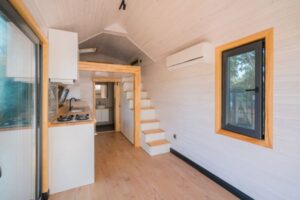In the bustling urban landscape, amidst the concrete jungles and fast-paced lifestyles, a yearning for a deeper connection with nature remains ever-present within the human spirit. Biophilic design, a revolutionary approach to interior design, emerges as a transformative solution to address this innate longing. Rooted in the principle of fostering a profound bond with the natural world, biophilic design celebrates the integration of nature into our living spaces, transcending the boundaries between indoors and outdoors. From grand estates to cozy small apartments, this design philosophy transcends scales, catering to the desires of urban dwellers seeking a harmonious and restorative living environment.
In the quest to infuse urban living spaces with the essence of nature, small apartments become the canvas for the art of biophilic design. Here, the principles of biophilia converge with the challenges of compact living, showcasing the remarkable power of nature to transform even the tiniest of abodes. As this article embarks on an enlightening journey, we delve into the captivating world of biophilic design and explore the diverse strategies that allow inhabitants to reconnect with the wonders of the natural world from the comfort of their own small apartments.
Within the embrace of biophilic design lies an acknowledgment of humanity’s intrinsic connection with the environment—a recognition that our well-being, productivity, and creativity are profoundly influenced by the presence of nature. As we unravel the layers of biophilic design in small apartments, we discover that it is not merely about incorporating a few plants or natural elements into the living space; rather, it becomes a transformative and holistic approach that encompasses all aspects of design, fostering a harmonious coexistence between human and nature.
From the lush greenery that breathes life into the living room to the cascading water features that create a sense of tranquility, biophilic design transcends the limitations of compact living, enabling inhabitants to savor the therapeutic embrace of the outdoors within the confines of their own small apartments. With each strategy, we reveal the profound impact of biophilic design—how it fosters well-being, reduces stress, and nurtures a sense of wonder and connection with the natural world.
As the cityscape continues to evolve and urban living becomes an integral part of modern society, the allure of biophilic design grows stronger, offering a retreat from the hustle and bustle of city life. In this journey, we witness the fusion of technology and innovation with the raw beauty of nature, as green walls coexist with smart home systems, and vertical gardens seamlessly blend with space-saving furniture. As urban dwellers seek to restore balance and harmony in their lives, biophilic design emerges as a guiding beacon, illuminating the path to a more sustainable, nurturing, and connected way of living.
In the embrace of biophilic design, small apartments cease to be mere living spaces; they become transformative sanctuaries—an ode to the wonder and beauty of the natural world, carefully crafted to nurture the mind, body, and soul. As we navigate the intricacies of biophilic design in small apartments, we uncover a timeless truth—that the essence of nature holds the key to unlocking the full potential of our living spaces and igniting a profound sense of joy, creativity, and serenity within us.
Greenery and Living Walls
One of the defining features of biophilic design is the integration of lush greenery and living walls within living spaces. In small apartments, where access to outdoor green spaces may be limited, the addition of indoor plants becomes an essential element of biophilic design.
Strategically placed potted plants and hanging greenery breathe life into the apartment, infusing it with a sense of freshness and vitality. The variety of plant species selected can cater to individual preferences and available light conditions, ensuring that the greenery thrives within the indoor environment.
Living walls, also known as vertical gardens, become a captivating focal point that invites nature indoors. These green installations not only enhance air quality but also create an immersive and sensory experience, connecting inhabitants with the essence of the natural world.
By incorporating greenery and living walls, small apartment dwellers can embrace the restorative power of nature and transform their living spaces into sanctuaries of green serenity.
Natural Elements and Materials
The art of biophilic design celebrates the use of natural elements and materials to bring the outdoors inside. From wood and stone to water features and natural textiles, these elements create a harmonious and grounding ambiance within small apartments.
Wooden furnishings, with their organic textures and warm hues, infuse the living space with a sense of natural beauty and timelessness. Stone accents, whether in the form of pebbles or natural stone tiles, add an earthy charm that resonates with the primal human connection to the land.
Water features, such as indoor fountains or cascading water walls, introduce the calming sound of flowing water, fostering a tranquil atmosphere reminiscent of serene natural settings. Natural textiles, such as cotton, linen, and wool, add softness and comfort, enhancing the tactile experience within the living space.
By embracing natural elements and materials, small apartment dwellers can evoke the soothing essence of nature, creating an environment that nurtures and rejuvenates the soul.
Maximizing Natural Light and Views
In biophilic design, the importance of natural light cannot be understated. Sunlight serves as a vital element that connects inhabitants with the rhythms of nature and positively influences their well-being.
In small apartments, optimizing natural light becomes a key design consideration. Large windows and glass doors invite sunlight indoors, creating a bright and uplifting living space. Removing heavy window treatments or opting for sheer curtains allows unobstructed views of the outdoors, blurring the boundaries between inside and outside.
Additionally, the arrangement of furniture and the use of reflective surfaces can amplify the effects of natural light, further illuminating the apartment and making it feel more spacious.
Maximizing views of nature also becomes a cornerstone of biophilic design. Whether it’s a cityscape, a nearby park, or a balcony garden, connecting with outdoor vistas fosters a sense of serenity and contemplation.
By embracing natural light and maximizing views, small apartment dwellers can bask in the therapeutic embrace of sunlight and reconnect with the ever-changing beauty of the outside world.
Sensory Experiences with Water and Sound
Biophilic design engages all the senses, and the incorporation of water and soothing sounds adds a multi-dimensional and immersive experience within the living space.
Water features, such as tabletop fountains or indoor ponds, introduce the calming presence of water, creating a sense of tranquility reminiscent of natural landscapes. The sound of flowing water adds a meditative quality to the living space, promoting relaxation and reducing stress.
In addition to water features, the integration of soothing sounds, such as nature sounds or gentle instrumental music, further enhances the sensory experience within the apartment. These sounds evoke a sense of connection with the natural world, inviting moments of reflection and rejuvenation.
By embracing sensory experiences with water and sound, small apartment dwellers can escape the urban clamor and find solace in an oasis of sensory tranquility.
Multi-Functional Nature Zones
Biophilic design celebrates the idea of nature zones within the living space, where the boundaries between indoor and outdoor living blur to create a seamless connection with the environment.
Balconies and terraces become natural extensions of the apartment, serving as serene outdoor retreats. By incorporating greenery, comfortable seating, and cozy textiles, these nature zones become sanctuaries for relaxation, reflection, and even gardening.
Indoor nature zones, on the other hand, offer dedicated spaces that invite inhabitants to engage with the natural world. Reading nooks bathed in natural light, meditation corners adorned with plants, and wellness spaces with water features contribute to the biophilic ambiance within the apartment.
By creating multi-functional nature zones, small apartment dwellers can embrace the spirit of biophilia and savor the enriching experience of living in harmony with nature.
Conclusion
As we conclude our enlightening journey through the world of biophilic design in small apartments, we are reminded of the transformative power of nature in enriching our living spaces. The five key strategies, from incorporating greenery and natural elements to maximizing natural light and sensory experiences, have unveiled the profound impact of biophilic design on our well-being and connection with the natural world.
In small apartments, where space may be limited, the principles of biophilic design offer an oasis of tranquility and rejuvenation. By embracing the art of bringing nature indoors, small apartment dwellers can craft living spaces that resonate with the primal human need for connection with the environment.
Biophilic design becomes a celebration of our inherent relationship with the natural world, infusing our living spaces with the restorative power of greenery, sunlight, and soothing sounds. In the midst of the urban hustle, biophilic design becomes a sanctuary—an invitation to reconnect, recharge, and find harmony within the confines of our beloved small apartments.



